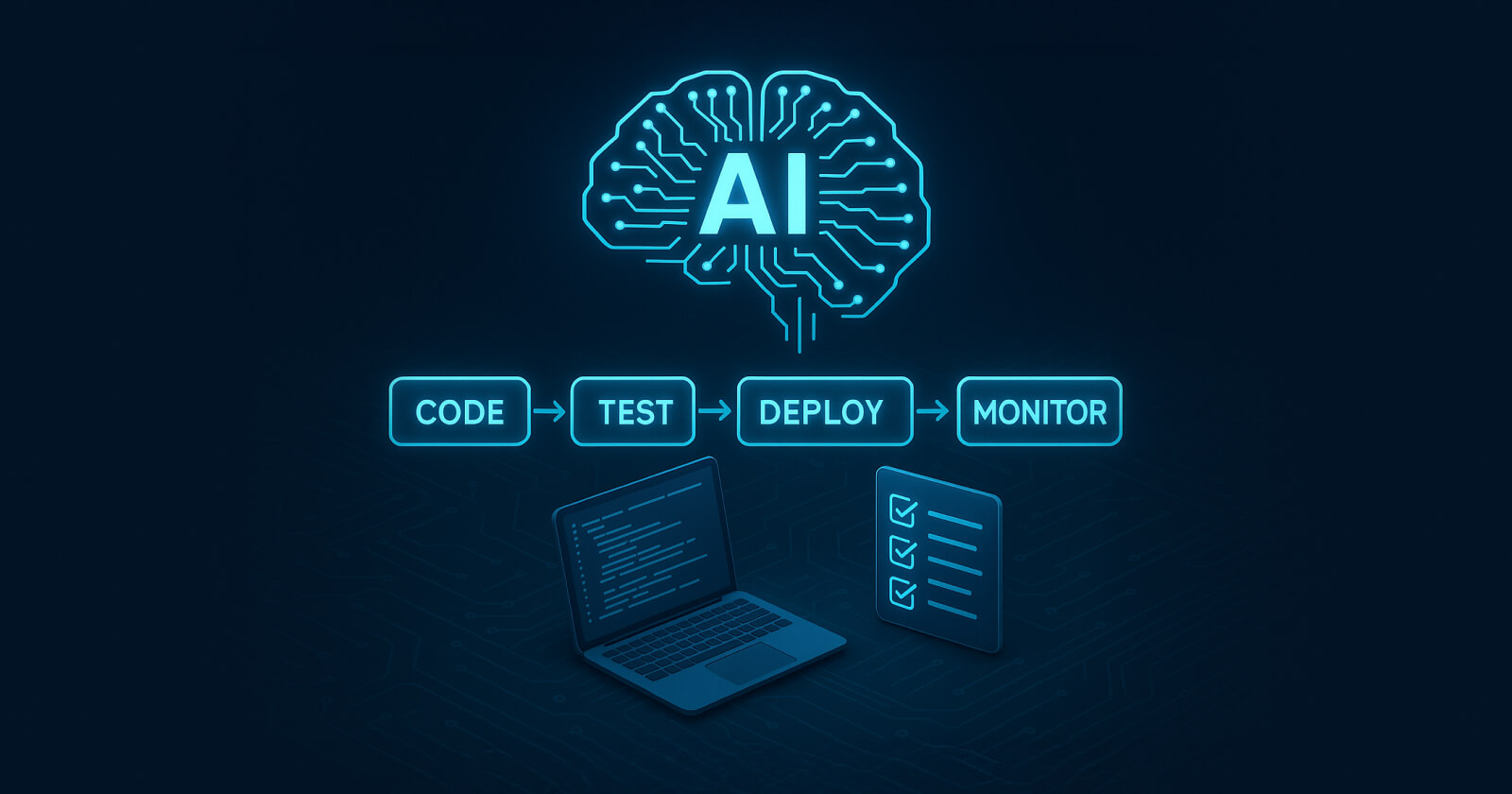October 9, 2025
AI-Powered Test Automation and QA: Driving a Smarter, Faster Software Development Lifecycle
Type
Deep DivesContributors
Eric Lee
AI is reshaping all aspects of the technology universe. And now it’s coming for software testing and quality assurance (QA). Over the past year, AI-powered code generation has become commonplace — virtually all developers (97%) in a recent GitHub survey indicated they have used an AI tool at some point. Agentic products such as Cursor, Windsurf, and Claude Code have correspondingly seen rapid adoption, with Cursor alone now reportedly generating nearly 1 billion lines of code daily. However, developers spend most of their time on noncoding tasks. Thus, as development velocity accelerates, attention is increasingly turning to test automation and quality assurance (QA).
Net new solutions powered by AI can do things that simply aren’t possible with traditional testing tools. For instance, AI-driven solutions can generate test cases, self-heal in response to application changes, and instantly analyze code to predict bugs. This fundamentally changes the software development lifecycle (SDLC) for testing and QA.
Let’s take a closer look at some of these net new capabilities:
- AI-generated test cases. Generative AI models and code agents can create unit tests or UI test scripts from requirements or source code. AI-driven test generation tools use techniques like reinforcement learning to produce human-readable test cases autonomously, accelerating coverage with minimal manual effort.
- Intelligent bug prediction. Modern AI can analyze application behavior, code, and test results to predict failures or pinpoint high-risk areas. This goes beyond executing predefined checks – the AI learns from past defects and code changes. In the past, QA could only react to failing tests, whereas AI can proactively highlight likely problem areas.
- Self-healing test automation. AI-powered test frameworks can automatically adapt to application changes, fixing broken test scripts and locators on the fly. This tackles a long-standing maintenance problem: in traditional automation, even small UI changes often break tests, requiring manual updates. AI-based auto-healing solutions observe patterns and dynamically update selectors or logic.
- Visual validation. Traditional pixel-by-pixel comparisons of screenshots are brittle and generate many false positives, as they can’t distinguish insignificant rendering shifts from real bugs. Visual AI can now “see” the application like a human, using computer vision to detect only meaningful differences in layout or content. Visual AI engines can analyze screens at the object level (text, images, layout) rather than by comparing raw pixels, virtually eliminating false positives.
- Test agents and exploratory testing. Emerging AI tools are beginning to mimic human testers, trying various inputs and actions to discover defects without explicit scripts. For example, AI bots can spider through a web app, dynamically learning the UI and attempting different workflows. This approach can uncover issues that scripted tests might miss, essentially performing unscripted QA at machine speed.
No more 10-year on-ramps
At Cota, we believe today is one of the best times ever to invest in the test automation and QA space. To understand why this is so, let’s take a quick look back at the history of QA testing.
In the 1990s and early 2000s, test automation was in its infancy. Most testing was manual, and the first generation of tools relied on simple record-and-playback of user interactions. Companies like Mercury Interactive and Segue provided script-based automation, but adoption was limited. QA teams often spent more time maintaining brittle scripts than executing them.
By the mid-2000s, with the rise of web applications, open-source frameworks like Selenium entered the UI test automation scene. This era saw increased automation of repetitive regression tests, yet progress was slow. Even by 2020, only about 15% of all testing was fully automated.
The Agile and DevOps movements in the 2010s ushered in “continuous testing,” by which QA was integrated into CI/CD pipelines. This pushed the adoption of API testing, unit testing, and service virtualization alongside UI tests. Test automation became more of a software engineering discipline in its own right, though it remained challenging to scale. By 2021, only 24% of organizations had automated even half of their test cases.
Historically, successful innovations in QA testing, such as open-source frameworks and DevOps tools, took close to a decade to mature and achieve broad enterprise penetration. We believe AI-driven testing is on an accelerated trajectory because of the urgent need for quality at speed.
AI testing is still at an early stage, but it’s growing fast. By 2023, only 15% of enterprises had integrated AI-based testing tools, a figure expected to surge to 80% by 2027. This kind of rapid adoption indicates that the industry sees AI as the answer to long-standing challenges. Unlike past transitions, which were gradual, the AI paradigm may be compressed into a few years due to the technology’s rapid advancements and the pressing need for better QA.
Converging trends drive growth
Including services, the test automation market is roughly $22.2B now and is expanding at an annual rate of about 17%. The adoption of AI technologies is improving the scope and efficiency of QA services, acting as a major growth catalyst. By 2029, Gartner projects that 90% of QA service providers will be using AI-augmented testing tools, up from about 20% in 2024.
Several converging trends are fueling the rapid rise of AI-powered test automation and QA in the software development lifecycle, including:
- The need for speed. Modern development practices such as Agile, CI/CD, and DevOps demand faster release cycles without any sacrifice in quality. Continuous integration requires tests to run continuously, creating a strong impetus for automation and, increasingly, the use of AI to further streamline testing. The introduction of AI represents a natural progression of this trend.
- Increasing software complexity. Today’s applications are more complex — multilayered architectures, microservices, rich UIs, countless user permutations — and they must run on a proliferation of devices and platforms (web, mobile, IoT). This complexity is straining traditional QA approaches. For instance, a banking app might need to be verified on dozens of browser/OS combinations and handle thousands of workflows. AI assists by intelligently prioritizing what to test and by enabling techniques like synthetic test data generation to cover edge cases.
- Shortage of QA talent. Skilled test automation engineers who can code tests and manage frameworks are in short supply. AI directly addresses this by amplifying productivity. Now, one engineer using AI can maintain a suite that previously required a team. We’re likely to see AI not just improve testing but also take over many repetitive QA tasks, causing a shift in QA roles.
- Regulatory demand for quality. Regulations and safety standards like GDPR and HIPAA explicitly or implicitly require robust software testing and validation, at the risk of legal penalties. This pushes companies to invest in more advanced QA to ensure compliance. AI aids here by enabling more exhaustive testing — for instance, generating test data that covers privacy edge cases or running scenario simulations at scale. The overall effect is that quality engineering is now a C-level concern, not just an IT issue.
- Maturation of the AI ecosystem. GenAI models have achieved dramatic improvements in accuracy on coding tasks, rising from roughly 30% accuracy with GPT-2 to as high as 86%–90% with GPT-4. At the same time, inference costs have fallen significantly — from about $60 per million tokens in 2021 to just $0.50 in 2024 — making large-scale testing, code review, and bug detection economically viable at scale. The emergence of agentic AI further amplifies this efficiency. Together, these forces are creating a step-change in both the speed and quality of software delivery.
The next big opportunity
In our next article, we’ll zoom in on specific subsegments within the AI-powered SDLC testing sector that we believe hold outsized potential for innovation and investment. We’ll explore why these areas stand out among the many opportunities that lie ahead.





